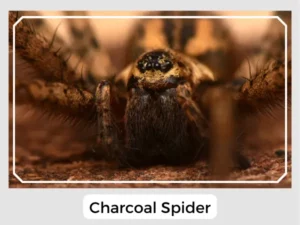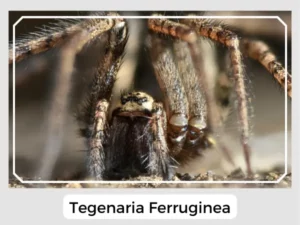The Tegenaria ferruginea, commonly known as the Charcoal Spider, is a fascinating species within the arachnid family. This creature has garnered attention from enthusiasts and researchers alike due to its unique characteristics and behavior. Understanding the Tegenaria ferruginea spider provides insight into the rich diversity of the spider world and its significance in various ecosystems.
The egg sacs of Charcoal spider are discreetly woven and placed in secluded areas. These sacs contain numerous eggs, ensuring the continuation of the species through the production of spiderlings.
Upon hatching, spiderlings are miniature versions of the adults, albeit lighter in color. These young spiders undergo several molts before reaching maturity, gradually darkening in color and growing in size.
Tegenaria ferruginea spiders construct sheet-like webs with a funnel-shaped retreat where they reside and wait for prey. These webs are often found in dark, undisturbed areas, providing a perfect trap for unsuspecting insects. 
Yes, like many spiders, Tegenaria ferruginea possesses venom used to subdue their prey. However, their venom is not harmful to humans under normal circumstances and is primarily focused on smaller insects and arthropods.
Although Charcoal spiders can bite, they do so very rarely, and only if provoked or threatened. Their bite is generally harmless to humans, causing minimal discomfort.
Natural Predator: Tegenaria ferruginea serves as a natural predator to many household pests, including insects and other arthropods. By controlling the population of these pests, they play a vital role in maintaining the ecological balance within their environment.
Prey-Predator Dynamics: These spiders are adept hunters, utilizing their webs to capture prey. This prey-predator dynamic is crucial for the regulation of insect populations, contributing to the stability of ecosystems.
Relationship with Humans: The relationship between humans and Tegenaria ferruginea spiders is largely beneficial, as they help reduce the population of pests in homes and gardens. Despite their presence being unwelcome to some, their ecological role is undeniably positive. 
| Distribution | Found in various parts of Europe and have been observed in other regions due to human activity. |
| Habitat | They prefer dark, undisturbed areas such as basements, sheds, and woodpiles. |
| Diet | Their diet primarily consists of insects and other small arthropods. |
| Lifespan | These spiders can live for several years, depending on environmental conditions. |
| Predators | They fall prey to larger predators, including birds and mammals. |
| IUCN Conservation Status | Currently, there is no specific conservation status for Tegenaria ferruginea, but they are not considered endangered. |
In summary, the Tegenaria ferruginea, or Charcoal Spider, is a compelling species that plays a significant role in our ecosystems. From their unique physical characteristics to their ecological importance, these spiders are more than just household inhabitants.
The Tegenaria ferruginea, commonly known as the Charcoal Spider, is a fascinating species within the arachnid family. This creature has garnered attention from enthusiasts and researchers alike due to its unique characteristics and behavior. Understanding the Tegenaria ferruginea spider provides insight into the rich diversity of the spider world and its significance in various ecosystems.
The egg sacs of Charcoal spider are discreetly woven and placed in secluded areas. These sacs contain numerous eggs, ensuring the continuation of the species through the production of spiderlings.
Upon hatching, spiderlings are miniature versions of the adults, albeit lighter in color. These young spiders undergo several molts before reaching maturity, gradually darkening in color and growing in size.
Tegenaria ferruginea spiders construct sheet-like webs with a funnel-shaped retreat where they reside and wait for prey. These webs are often found in dark, undisturbed areas, providing a perfect trap for unsuspecting insects. 
Yes, like many spiders, Tegenaria ferruginea possesses venom used to subdue their prey. However, their venom is not harmful to humans under normal circumstances and is primarily focused on smaller insects and arthropods.
Although Charcoal spiders can bite, they do so very rarely, and only if provoked or threatened. Their bite is generally harmless to humans, causing minimal discomfort.
Natural Predator: Tegenaria ferruginea serves as a natural predator to many household pests, including insects and other arthropods. By controlling the population of these pests, they play a vital role in maintaining the ecological balance within their environment.
Prey-Predator Dynamics: These spiders are adept hunters, utilizing their webs to capture prey. This prey-predator dynamic is crucial for the regulation of insect populations, contributing to the stability of ecosystems.
Relationship with Humans: The relationship between humans and Tegenaria ferruginea spiders is largely beneficial, as they help reduce the population of pests in homes and gardens. Despite their presence being unwelcome to some, their ecological role is undeniably positive. 
| Distribution | Found in various parts of Europe and have been observed in other regions due to human activity. |
| Habitat | They prefer dark, undisturbed areas such as basements, sheds, and woodpiles. |
| Diet | Their diet primarily consists of insects and other small arthropods. |
| Lifespan | These spiders can live for several years, depending on environmental conditions. |
| Predators | They fall prey to larger predators, including birds and mammals. |
| IUCN Conservation Status | Currently, there is no specific conservation status for Tegenaria ferruginea, but they are not considered endangered. |
In summary, the Tegenaria ferruginea, or Charcoal Spider, is a compelling species that plays a significant role in our ecosystems. From their unique physical characteristics to their ecological importance, these spiders are more than just household inhabitants.